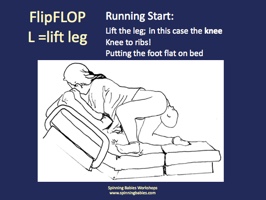There is a special action that happens with Running Start. One side of the pubic bone does a tiny twist or tilt. That tilting motion is called “nutate” by Physical Therapists. The bones to the side of the pelvis (of the raised knee) move outward creating more space in the middle and lower pelvis.

Open the midpelvis and outlet with a side lunge or with Running Start.
The difference in these two favorite positions is that the raised knee in Running Start is placed closer to the person’s rib cage. A side lunge can have the knee further from the body. Both make some room in the midpelvis and outlet. A lunge let’s the foot aim slightly away from the body, diagonally.
The side lunge is more comfortable and suited for a baby whose entirely inside the pelvis. Running Start is worth trying, however, for 2-3 contractions for a posterior baby who is deep in the pelvis but not yet visible. (Expect better results with a posterior baby if you do Side-lying Release first.)
Running Start is ideal for the baby whose head is born but the shoulder may be held back on the pubic bone.
Learn more about Running Start and freeing a stuck shoulder on Gail Tully’s online course for birth professionals, Resolving Shoulder Dystocia. It’s a 3-hour course with continuing education for midwives. See it in the shop.